Bestsellers
-

JOY-iT JOY-iT Motorino - Motor Control voor Arduino
Het Motorino bord is een uitbreidingsbord om tot 16 PWM-gestuurde 5V-Servo-motoren aan te sturen en te gebruiken. De bijgeleverde klokgenerator zorgt voor een zeer nauwkeurig PWM-signaal en een zeer nauwkeurige positionering. Het bord heeft 2 ingangen voor een spanning van 4,8 V tot 6 V die gebruikt kan worden voor maximaal 11 A. Met deze ingang is een perfecte stroomvoorziening altijd gegarandeerd en zijn zelfs grotere projecten geen probleem. De voeding loopt direct over de Motorino die zorgt voor een aansluiting voor spanning, massa en aansturing. Met de ingebouwde condensator wordt de spanning gebufferd wat een plotselinge spanningsval bij een hoge belasting voorkomt. Maar er is ook de mogelijkheid om een andere condensator aan te sluiten. De besturing en het programmeren kan, zoals gebruikelijk, met de Arduino. Handleidingen en code voorbeelden maken een snelle introductie voor beginners mogelijk. Speciale kenmerken 16 Kanalen, eigen klok generator Input 1 Coaxiale voedingsconnector 5,5 / 2,1 mm, 4,8-6 V / 5 A max Input 2 Schroef-terminal, 4,8-6 V / 6 A max Communicatie 16 x PWM Compatibel met Arduino Uno, Mega en wellicht meer microcontroller met Arduino-compatibele pinout Afmetingen 69 x 24 x 56 mm Werkingssfeer Bord, Handleiding, Winkelverpakking
€ 26,95
Leden € 24,26
-
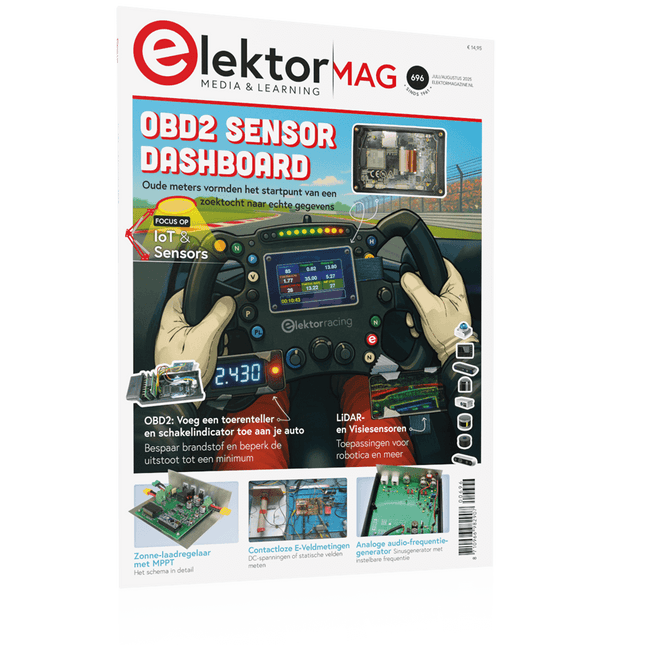
Elektor Juli/Augustus 2025 (NL)
Elektor GREEN en GOLD leden kunnen deze uitgave hier downloaden. Nog geen lid? Klik hier om een lidmaatschap af te sluiten. OBD2-sensordashboardOude meters vormden het startpunt van een zoektocht naar echte gegevens OBD2: voeg een toerenteller en schakelindicator toe aan je autoRetro, maar uiterst nuttig LiDAR- en Visiesensoren voor Robotica Sensor+Test 2025 en PCIM 2025 Contactloze E-Veldmetingen (1)Een Trillende Membraan voor het Detecteren van Gelijkspanningen of Statische Elektrische Velden Draadloze brievenbusmeldervan optische sensoren tot radar: enkele mogelijkheden Elektor Mini-Wheelieeen zelfbalancerende robot ZonnecellenVreemde onderdelen, de serie Aan de slag met een moderne radarsensorStaat een nauwkeurige meting op uw radar? Uit het leven gegrepenpapierfabriek CybersecurityZware tijden voor hackers Infographics: IoT en sensoren 2025 Bluetooth 6.0 brengt verbeterde toepassingen voor afstandsbepalingNieuwe versie biedt betere apparaatpositionerings- en -locatieservices Draadloze communicatie verkennen met BeagleY-AI Err-lectronicsCorrecties, updates en lezerspost Alle begin......sluit het thema opamps af Een krachtige AI-codeerassistentsneller ontwikkelen met Continue en Visual Studio Code Zonne-laadregelaar met MPPT (2)Het schema Ultrasone obstakeldetectoreen eenvoudig project om slechtzienden te helpen 2025: Een AI-odysseeHalfjaaroverzicht Raspberry Pi Standalone MIDI-synthesizer (3)Het slimmer maken en een gebruikersinterface toevoegen Meshtastic: een demonstratieprojectEen slim netwerk van LoRa-radio's Analoge audio-frequentiegeneratorHoogwaardige sinusgenerator met instelbare frequentie
€ 14,95
-

Generic AD584 4-kanaals Spanningsreferentiemodule (10 V)
De AD584 4-kanaals spanningsreferentiemodule is ontworpen om stabiele en nauwkeurige referentiespanningen van 2,5 V, 5 V, 7,5 V en 10 V te leveren. Het bevat het AD584 geïntegreerde circuit, bekend om zijn hoge nauwkeurigheid en stabiliteit. Kenmerken Meerdere uitgangsspanningen: De module kan vier verschillende referentiespanningen (2,5 V, 5 V, 7,5 V en 10 V) afgeven die toegankelijk zijn via een enkele poort. Microcontroller-gebaseerde schakeling: Een ingebouwde microcontroller vergemakkelijkt het schakelen tussen de vier spanningsuitgangen, met LED-indicatoren die de actieve selectie weergeven. Gebruiksvriendelijke bediening: Een enkele knop maakt het mogelijk om eenvoudig door de beschikbare referentiespanningen te bladeren. Transparante behuizing: De module is omhuld door een transparante behuizing, die bescherming biedt terwijl gebruikers de interne componenten kunnen bekijken. Voedingsopties: Het kan worden gevoed via een ingebouwde lithiumbatterij (niet meegeleverd) of via een 5 V DC-ingang. Een laadindicator geeft statusupdates tijdens het opladen. Uitvoerinterface: Uitgerust met 4mm-banaanaansluitingen voor veilige en betrouwbare verbindingen. Inbegrepen 1x AD584 4-kanaals spanningsreferentiemodule met behuizing Downloads Datasheet
€ 22,95€ 11,50
Leden identiek
-

Elektor Digital Starten met Internet of Things (E-book)
35 projecten met Raspberry Pi en wireless Arduino Internet of Things (alles aan het internet) is een trend die zich niet meer laat keren. We willen alles in huis met onze mobiel of tablet doen, van Facebook tot TV kijken, van lichten bedienen tot de temperatuur in de gaten houden. In dit boek laten we in 35 leuke en handige projecten zien hoe u op eenvoudige wijze zelf een Internet of Things systeem kunt aanleggen. We gaan in op de hardware (de perfecte combinatie van Raspberry Pi en Arduino) en de software om bediening via internet mogelijk te maken. We maken gebruik van Wi-Fi en radioverbindingen zodat er geen kabels dwars door uw huis hoeven. Wanneer u deze projecten maakt heeft u een compleet Internet of Things systeem waarmee u van alles in uw huis kunt bedienen en bekijken. Bijvoorbeeld of er post in de brievenbus ligt en of de auto in de garage staat. U kunt op vanaf de bank het licht aandoen en het alarm bedienen. Door de heldere uitleg kunt u de projecten eenvoudig aanpassen om bijvoorbeeld uw koffiezetautomaat of tv op afstand aan te zetten. Via de index vindt u gemakkelijk creatieve projecten die als voorbeeld kunnen dienen, zodat u zelfstandig alles met het internet kunt verbinden.
€ 29,95
Leden € 23,96
-

Elektor Digital Elektor Summer Circuits 2022 (PDF)
Meer dan 50 schakelingen & projecten US-sirene Twee draai-encoders op één analoge ingang Digitale 220VAC-dimmer met Arduino Stroombron voor LED’s Vier schakelaars detecteren met één pin Kleine aan/uit-schakelaar met accucontrole Desinfectie-dispenser voor zelfbouw Eenvoudig elektronisch orgel Simpele stereoversterker Audiogestuurde schakelaar Gebalanceerd/ongebalanceerd-converter Extern netfilter Knoploze garagedeurbediening DI-box voor smartphone Pret met een looplicht Eenknops-thyristorbesturing Quasi-analoge belichtingstimer voor de donkere kamer Schakelingen bij de Hackster.io-community Analoge zonnebad-timer Weer een eendraads LCD-interface Simpele PWM-generator met AVR ATtiny13 Een tweede leven voor batterijen Aanraakschakelaar voor LED-verlichting Tester voor LED’s en DIP-schakelaars IR-afstandsbedieningstester Tester voor vermogens-halfgeleiders SPI voor WS2812(B)-LED’s Meten van vermogens-zelfinducties Eén stekker voor Raspberry Pi en Audio DAC Doe-het-zelf meetklem voor de LCR-meter Arduino-ampèremeter Tweevinger-orgel Ruisarme ADC-kalibrator DC/DC-boostconverter Twee potmeters op één digitale ingang Akoestische nabijheidssensor Batterijloze radiatorsensor Speurneus voor draadloze camera’s en microfoons Timer voor auto-binnenverlichting Kaarssimulator Digitale keukentimer Milliohm-meter Warmwatervertrager Eenvoudige lader voor twee (of meer) 18650-cellen Mini-frequentiereferentie Zuinige IR-schakelaar Hergebruik de telefoonlader van je auto Microfoon-voorversterker voor Arduino EMI-filters voor zelfbouw Elektronische dobbelsteen zonder MCU Vingercondensator Zelfladende flits-LED Ook in deze editie KiCad 6 – vijf interessante nieuwe functies Retrotronica – de Elektor SC/MP-computer Interview – kunst maken met elektriciteit Mijn eerste print – spring in het diepe... met KiCad Met slimme software de hardware minimaliseren Elektor Infographics – feiten en cijfers Nieuwe componenten van Analog Optimalisering van de signaalintegriteit – Industry 4.0 vereist vlekkeloos werkende interfaces7 Hexadoku – puzzelen voor elektronici
€ 9,95
-

Elektor Digital Elektor Novembre/Décembre 2024 (PDF)
Le téléchargement intégral de ce numéro est disponible pour nos membres GOLD et GREEN sur le site Elektor Magazine ! Pas encore membre ? Cliquez ici. Prototypage, production et composants ! carte processeur Audio DSP FXpartie 1 : caractéristiques et conception 50 ans d'Elektor en anglais KiCad 8nouvelles et dernières caractéristiques Elektor @ electronica 2024electronica Fast Forward 2024, des experts sur scène, des forums d'influenceurs, des talk-shows Elektor Lab en direct, et plus encore kit MultiCalculator d'ElektorUn kit de calculatrice basé sur Arduino pour l'électronique systèmes GNSS RTK à faible coûtavec un degré de précision de l'ordre du centimètre routage des Circuits Imprimés et sécuritéConseils pour une conception sure et fiable de vos cartes électroniques testeur d'ampli-oppour les applications audio et autres mise à jour du projet #4 : compteur d'énergie ESP32surveiller l'énergie avec MQTT analyseur de spectre temps-réel à technologie guide d’onde et PC à interfaces multiplesAaronia introduit une nouvelle ligne de produit et présente ses premiers prototypes au salon Electronica de Munich inductances SMTbobines et ferrites – un choix simplifié utilisation d’un blindage EMI pour assurer la conformité à la compatibilité électromagnétique l'outil ultime pour tous les passionnés d’électroniqueDébloquez des possibilités infinies avec Red Pitaya et plus de 1000 Click Boards™ HDI au milieuUn nouveau service PCB-pooling rentable pour des petits BGA défis de l'analyse DFM pour les circuits flexibles et flexibles-rigides outils open-sourcesimulateur d'antennes, gestion des composants, calculatrice, et bien plus Infographie : prototypage et production sur le vifmicrotechnophobie : c’est grave, docteur ? arbre de Noël 3Dcircuit imprimé 3D avec un microcontrôleur 32 bits peu coûteux démarrer en électronique......on continue avec l'ampli-op ! nœud de capteurs autonome (mise à jour du projet #1)Reducing Idle Power Consumption with External RTC and Power Switch 2024 : l'odyssée de l'IAUn regard sur l'avenir afficheurs LED avec le MAX7219Une méthode pratique pour une excellente puce projet 2.0Corrections, mises à jour et courrier des lecteurs gants vibro-tactilesune avancée pour les patients de Parkinson
€ 10,95
-

Cytron Cytron Motion 2350 Pro Robotics-controller
De Cytron Motion 2350 Pro is een robuuste 4-kanaals DC-motordriver (3 A per kanaal, 3,6-16 V), ideaal voor het bouwen van krachtige robots, inclusief mecanumwielontwerpen. Het beschikt over 8-kanaals 5 V-servopoorten, 8-kanaals GPIO-breakouts, 3 Maker-poorten en een USB-host voor plug-and-play joystick/gamepad-ondersteuning. Aangedreven door Raspberry Pi Pico 2, integreert het naadloos met het Pico-ecosysteem en ondersteunt Python (MicroPython, CircuitPython), C/C++ en Arduino IDE. Het is vooraf geïnstalleerd met CircuitPython en wordt geleverd met een demoprogramma en snelle testknoppen voor onmiddellijk gebruik. Maak eenvoudig verbinding via USB-C en begin met verkennen! Inbegrepen 1x Cytron Motion 2350 Pro Robotics-controller 1x STEMMA QT/Qwiic JST SH 4-pins kabel met vrouwelijke aansluitingen (150 mm) 2x Grove naar JST-SH-kabel (200 mm) 1x Set siliconen bumpers 4x Bouwsteenfrictiepin 1x Mini-schroevendraaier
€ 29,95€ 24,95
Leden identiek
-
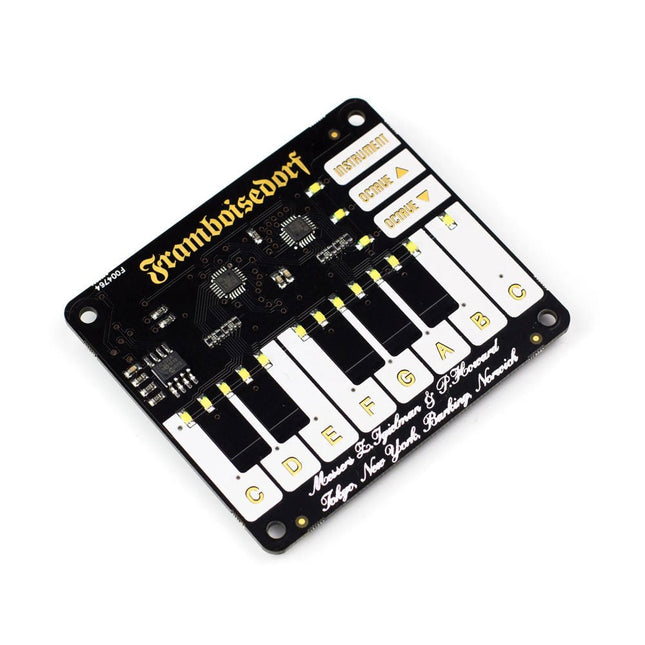
Pimoroni Pimoroni Piano HAT voor de Raspberry Pi
Laat uw innerlijke Mozart bovenkomen met de Piano HAT, een mini muzikale metgezel voor uw Raspberry Pi! De Piano HAT is geïnspireerd op de PiPiano van Zachary Igielman en gemaakt met zijn instemming. We hebben zijn fantastische idee om een kleine piano add-on te bouwen voor de Raspberry Pi overgenomen, deze aanraakgevoelig gemaakt, en netjes afgewerkt met veel van onze kenmerkende Pimoroni lak. Speel muziek af in Python, bedien softwaresynths op je Pi, en pak zelf de controle over hardwaresynthesizers! Kenmerken 16 capacitieve touchpads (elk te koppelen aan hun eigen Python functie!) 13 pianotoetsen (een volledig octaaf) Octaaf omhoog/omlaag knoppen Knop voor instrumentcyclus (ideaal voor gebruik met synthesizers) 16 helderwitte leds (laat ze automagisch oplichten of neem de controle over met Python) 2x Microchip CAP1188 capacitieve touch driver chips Gebruik hem om software- of hardwaresynths te besturen via MIDI Compatibel met alle 40-pins header Raspberry Pi modellen Wordt volledig gemonteerd geleverd Downloads Python library Pinout
€ 29,95
Leden € 26,96
-
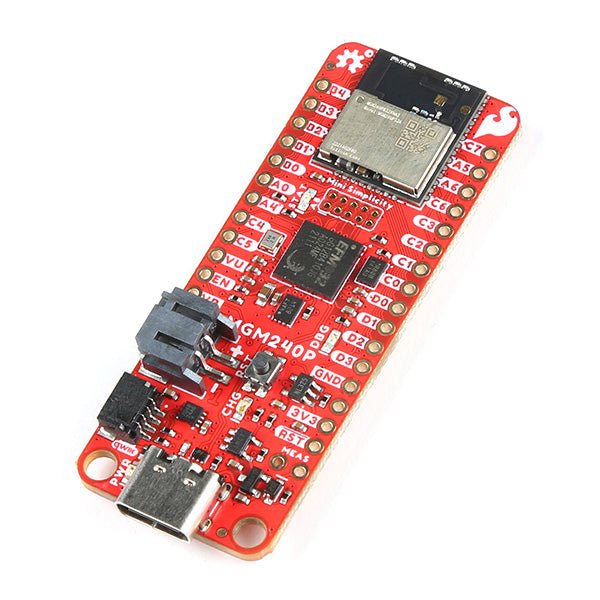
SparkFun SparkFun Thing Plus Matter (MGM240P)
The SparkFun Thing Plus Matter is the first easily accessible board of its kind that combines Matter and SparkFun’s Qwiic ecosystem for agile development and prototyping of Matter-based IoT devices. The MGM240P wireless module from Silicon Labs provides secure connectivity for both 802.15.4 with Mesh communication (Thread) and Bluetooth Low Energy 5.3 protocols. The module comes ready for integration into Silicon Labs' Matter IoT protocol for home automation. What is Matter? Simply put, Matter allows for consistent operation between smart home devices and IoT platforms without an Internet connection, even from different providers. In doing so, Matter is able to communicate between major IoT ecosystems in order to create a single wireless protocol that is easy, reliable, and secure to use. The Thing Plus Matter (MGM240P) includes Qwiic and LiPo battery connectors, and multiple GPIO pins capable of complete multiplexing through software. The board also features the MCP73831 single-cell LiPo charger as well as the MAX17048 fuel gauge to charge and monitor a connected battery. Lastly, a µSD card slot for any external memory needs is integrated. The MGM240P wireless module is built around the EFR32MG24 Wireless SoC with a 32-bit ARM Cortext-M33 core processor running at 39 MHz with 1536 kb Flash memory and 256 kb RAM. The MGM240P works with common 802.15.4 wireless protocols (Matter, ZigBee, and OpenThread) as well as Bluetooth Low Energy 5.3. The MGM240P supports Silicon Labs' Secure Vault for Thread applications. Specifications MGM240P Wireless Module Built around the EFR32MG24 Wireless SoC 32-bit ARM-M33 Core Processor (@ 39 MHz) 1536 kB Flash Memory 256 kB RAM Supports Multiple 802.15.4 Wireless Protocols (ZigBee and OpenThread) Bluetooth Low Energy 5.3 Matter-ready Secure Vault Support Built-in Antenna Thing Plus Form-Factor (Feather-compatible): Dimensions: 5.8 x 2.3 cm (2.30 x 0.9") 2 Mounting Holes: 4-40 screw compatible 21 GPIO PTH Breakouts All pins have complete multiplexing capability through software SPI, I²C and UART interfaces mapped by default to labeled pins 13 GPIO (6 labeled as Analog, 7 labeled for GPIO) All function as either GPIO or Analog Built-in-Digital to Analog Converter (DAC) USB-C Connector 2-Pin JST LiPo Battery Connector for a LiPo Battery (not included) 4-Pin JST Qwiic Connector MC73831 Single-Cell LiPo Charger Configurable charge rate (500 mA Default, 100 mA Alternate) MAX17048 Single-Cell LiPo Fuel Gauge µSD Card Slot Low Power Consumption (15 µA when MGM240P is in Low Power Mode) LEDs: PWR – Red Power LED CHG – Yellow battery charging status LED STAT – Blue status LED Reset Button: Physical push-button Reset signal can be tied to A0 to enable use as a peripheral device Downloads Schematic Eagle Files Board Dimensions Hookup Guide Datasheet (MGM240P) Fritzing Part Thing+ Comparison Guide Qwiic Info Page GitHub Hardware Repo
€ 34,95€ 17,50
Leden identiek
-
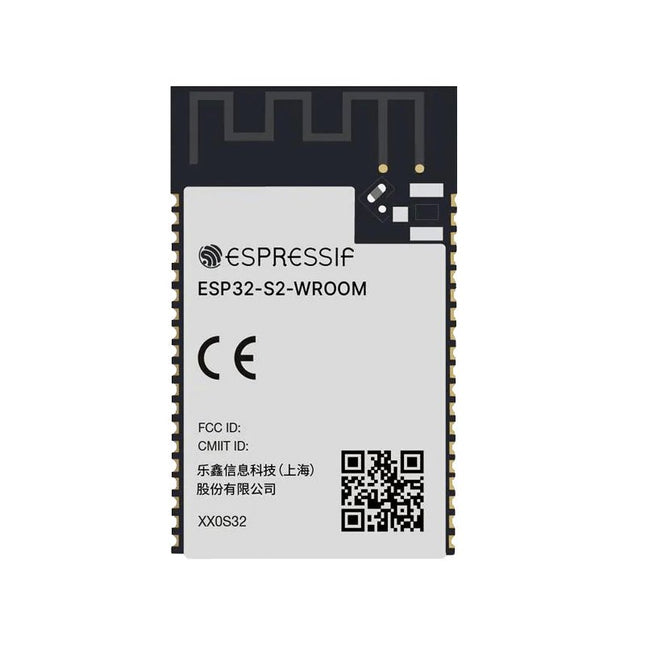
Espressif ESP32-S2-WROOM
At the core of this module is ESP32-S2, an Xtensa® 32-bit LX7 CPU that operates at up to 240 MHz. The chip has a low-power co-processor that can be used instead of the CPU to save power while performing tasks that do not require much computing power, such as monitoring of peripherals. ESP32-S2 integrates a rich set of peripherals, ranging from SPI, I²S, UART, I²C, LED PWM, TWAITM, LCD, Camera interface, ADC, DAC, touch sensor, temperature sensor, as well as up to 43 GPIOs. It also includes a full-speed USB On-The-Go (OTG) interface to enable USB communication.FeaturesMCU ESP32-S2 embedded, Xtensa® single-core 32-bit LX7 microprocessor, up to 240 MHz 128 KB ROM 320 KB SRAM 16 KB SRAM in RTC WiFi 802.11 b/g/n Bit rate: 802.11n up to 150 Mbps A-MPDU and A-MSDU aggregation 0.4 µs guard interval support Center frequency range of operating channel: 2412 ~ 2484 MHz Hardware Interfaces: GPIO, SPI, LCD, UART, I²C, I²S, Camera interface, IR, pulse counter, LED PWM, TWAI (compatible with ISO 11898-1), USB OTG 1.1, ADC, DAC, touch sensor, temperature sensor 40 MHz crystal oscillator 4 MB SPI flash Operating voltage/Power supply: 3.0 ~ 3.6 V Operating temperature range: –40 ~ 85 °C Dimensions: 18 × 31 × 3.3 mm Applications Generic Low-power IoT Sensor Hub Generic Low-power IoT Data Loggers Cameras for Video Streaming Over-the-top (OTT) Devices USB Devices Speech Recognition Image Recognition Mesh Network Home Automation Smart Home Control Panel Smart Building Industrial Automation Smart Agriculture Audio Applications Health Care Applications Wi-Fi-enabled Toys Wearable Electronics Retail & Catering Applications Smart POS Machines
€ 6,95
Leden € 6,26
-
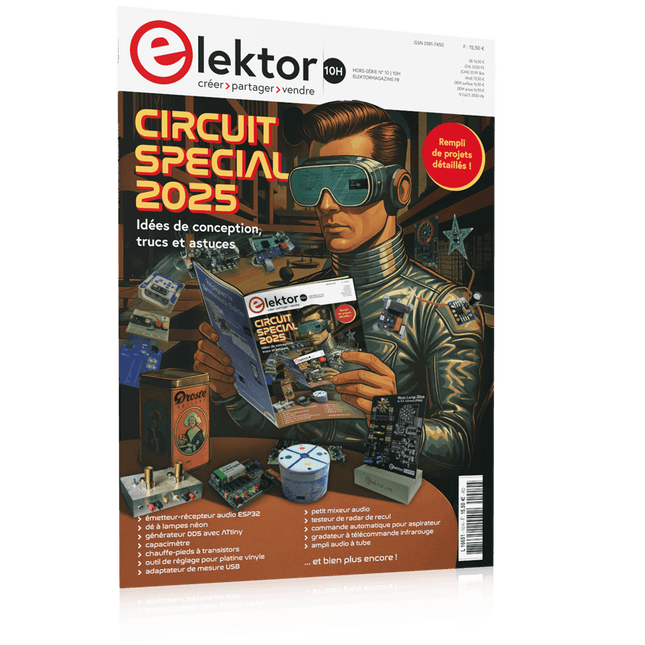
Elektor Circuit Special 2025 (FR)
Le téléchargement intégral de ce numéro est disponible pour nos membres GOLD et GREEN sur le site Elektor Magazine ! Pas encore membre ? Cliquez ici. adaptateur de mesure USBTest du courant et des signaux des ports USB sortie boucle de courant 4-20 mA pour Arduino UnoUne interface de boucle de courant fiable et insensible aux interférences électromagnétiques commande automatique pour aspirateurGardez votre établi propre générateur DDS avec ATtiny testeur d'ampli-op V2Nouveau circuit imprimé – désormais compatible avec les CMS amplificateur audio à tube 550 mWson chaleureux des tubes à vide surveillance des fusiblesavec une LED clignotante préamplificateur RIAA HQExploitez tout le potentiel sonore de vos disques vinyles ! Outil de réglage pour platines vinylesGénérateur de lumière stroboscopique 100–120 Hz basé sur Arduino Elektor Classics : ampli vidéo gradateur à télécommande infrarougeContrôlez votre éclairage avec confort et précision comment utiliser switch…case avec des chaînes de caractères en C++/EDI Arduino détecteur d’aimantsAvec un simple capteur à effet Hall bouton de mise sous tension intelligent pour Raspberry PiUne solution pour Raspberry Pi jusqu’au modèle 4 astuces clés pour makersDes conseils pros pour vos projets projets pratiques avec le timer 555Commande de moteur CC et jeux de rapidité moniteur de charge CA simpleÉconomisez de l'énergie grâce à un appareil simple batteries externes en parallèleTrois jours d’autonomie VFO jusqu’à 15 MHzRéalisation avec un Raspberry Pi Pico accordeur de violon avec ATtiny202 Elektor Classics : ampli vidéo pour TV N&B capacimètre20 pF à 600 nF horloge quasi analogique Mk IIDeux anneaux LED pour les heures et les minutes concevez sans limites(grâce à l’écosystème complet d’Arduino) dé à lampes néon Elektor Classics : indicateur d'accord RTTY solutions matérielles inspirantes pour vos projets ESP Elektor Classics : alimentation 3 A LED RGB avec circuit de commande intégréLumière de précision : les ICLED établissent de nouvelles normes expérience : un Thérémine analogico-numérique ?Combiner des capteurs numériques modernes avec l’intemporel générateur analogique XR2206 carte émetteur-récepteur audio ESP32 (1)Démo : lecture de fichiers WAV depuis une carte SD infographies : Circuits et conception de circuits 2025 petit mixeur audioUne conception polyvalente et modulable minuteur intelligent pour éclairage d’escalierÉconomisez encore plus sur votre facture d’énergie ! modernisez vos voletsContrôlez les systèmes Velux avec un ESP32 et MQTT chauffe-pieds à transistorsConfort économe en énergie le quadricoptère M5Stamp Fly est-il le prochain drone Tello ? (Revue) optimiser la portée Wi-Fi de l’ESP32-C3 SuperMiniUne modification d’antenne simple et efficace station de soudage à air chaud ZD-8968Un outil de travail économique ou uniquement de l'air chaud ? testeur de radar de reculDétecter les pannes du système d’aide au stationnement d’un véhicule
€ 15,50
-

Elektor Juillet/Août 2025 (FR)
Le téléchargement intégral de ce numéro est disponible pour nos membres GOLD et GREEN sur le site Elektor Magazine ! Pas encore membre ? Cliquez ici. tableau de bord OBD2Des cadrans anciens aux données en temps réel OBD2 : ajoutez un compte-tours et un indicateur de changement de vitesse à votre voitureRétro, mais extrêmement utile capteurs de vision et LiDAR pour la robotique Sensor+Test 2025 et PCIM 2025 mesures sans contact du champ électrique (1)Membrane vibrante pour mesurer des tensions continues ou des champs électriques statiques détecteur de courrier sans filCapteurs optiques, radars… quelques options à explorer Elektor Mini-WheelieUn robot auto-équilibré cellules solairesDrôles de composants, la série premiers pas avec un capteur radar moderneUn capteur précis qui ne passe pas inaperçu sur le vifUsine de papier CybersécuritéDes temps difficiles pour les hackers Infographie : IdO et capteurs le Bluetooth 6.0 pour des applications de télémétrie amélioréesCette nouvelle version offre des fonctions de localisation améliorées découvrez la communication sans fil avec BeagleY-AI Projet 2.0Corrections, mises à jour et courrier des lecteurs démarrer en électronique……Conclusion sur les ampli-op un puissant assistant de codage de l'IAAccélérez votre développement avec Continue et Visual Studio Code contrôleur de charge solaire avec MPPT (2)Le circuit détecteur d'obstacles à ultrasonsUn projet simple pour aider les malvoyants une odyssée de l'IABilan du premier semestre synthétiseur MIDI autonome Raspberry Pi (3)plus intelligent avec une interface utilisateur Meshtastic : un projet de démoUn réseau intelligent de noeuds LoRa générateur analogique de fréquences audioGénérateur de signaux sinusoïdaux de haute qualité à fréquence réglable
€ 15,50
-
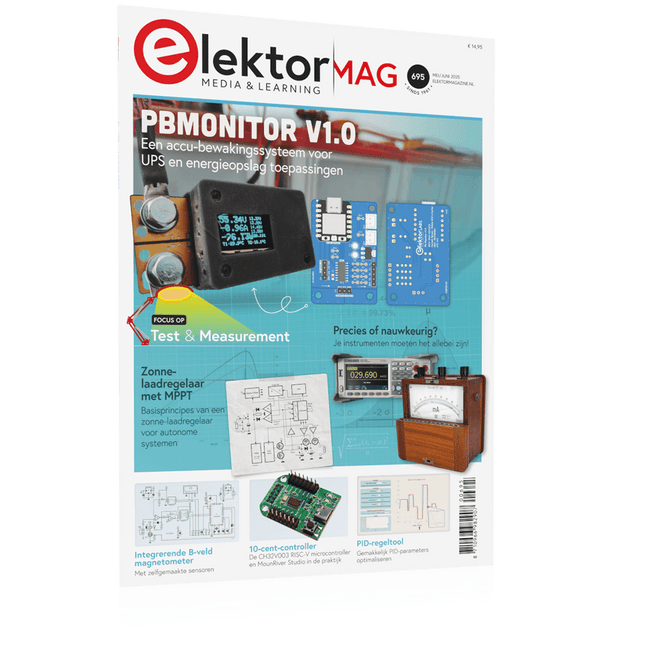
Elektor Mei/Juni 2025 (NL)
Elektor GREEN en GOLD leden kunnen deze uitgave hier downloaden. Nog geen lid? Klik hier om een lidmaatschap af te sluiten. PbMonitor v1.0Een accu-bewakingssysteem voor UPS en energieopslag toepassingen Zonne-laadregelaar met MPPT (1)basisprincipes van een zonne-laadregelaar voor autonome systemen Integrerende B-veld magnetometermet zelfgemaakte sensoren Precies of nauwkeurig?Je instrumenten moeten het allebei zijn! AD7124 Een precisie-ADC in de praktijkEssentieel voor Sensorsignaalconditionering PID-regeltoolGemakkelijk PID-parameters optimaliseren embedded world 2025 Alle begin......gaat verder met de toonregeling Academy Pro BoxBoek + onlinecursus + hardware Milliohmmeter adapterGebruik de nauwkeurigheid van uw multimeter De volgende sprong in halfgeleidersVoorwaarts naar 1,4nm Through-hole connectorenHet beste van twee werelden: THR FrequentietellerDraagbaar en Automatische Kalibratie met GPS Analoge metersVreemde onderdelen, de serie Stand-alone kristaltesterhoe nauwkeurig is uw kloksignaal? Goedkope I²C-testersluit I²C-apparaten rechtstreeks op uw PC aan Uit het leven gegrepenwie het kleine niet eert... 2025: een AI-odysseede transformerende invloed op softwareontwikkeling Err-lectronicsCorrecties, updates en ingezonden brieven Raspberry Pi standalone MIDI-synthesizer (2)We verbeteren onze setup met intelligentie Norton-getransformeerde wienbrug-oscillatorkleine verandering, grote verbetering Test van een 10-cent-controllerde CH32V003 RISC-V microcontroller en MounRiver Studio in de praktijk Een FPGA-gebaseerde audiospeler met equalizer (2)volumeregeling, geavanceerd mixen en een webinterface
€ 14,95
-
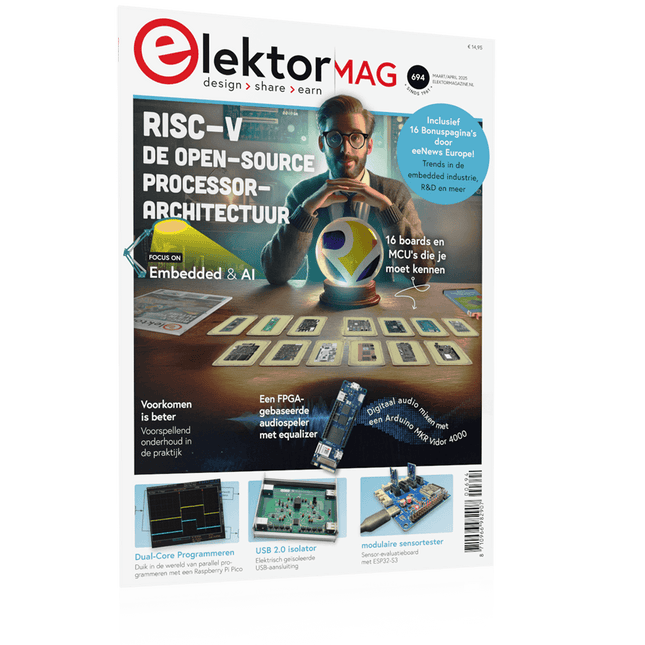
Elektor Maart/April 2025 (NL)
Elektor GREEN en GOLD leden kunnen deze uitgave hier downloaden. Nog geen lid? Klik hier om een lidmaatschap af te sluiten. De open-source processorarchitectuur RISC-V16 boards en MCU's die je moet kennen Een FPGA-gebaseerde audiospeler met equalizer (1)Digitaal audio mixen met een Arduino MKR Vidor 4000 Laserkop voor pico-gebaseerde zandklokTekenen met licht Doe mee aan de STM32 Edge AI Contest Een multi-sensor plantenmonitor-systeemdraadloze meting van watertoevoer en lichtomstandigheden Maixduino AI-gestuurde automatische portiergezichtsdetectie met een camera Embedded Electronics 2024AI gaat de industrie opnieuw vormgeven Lading-gebaseerde in-Memory computing bij EnCharge AI AI-Inferentie met 10 Keer Lager Energieverbruik en 20 Keer Lagere Kosten Click board ondersteunt het ontwikkelen en trainen van ML-modellen voor trillingsanalyse De Elektor Mini-WheelieEen kit voor een zelfbalancerende robot MCU, ik zie jeMCUViewer: open-source multiplatform debugging-tool USB 2.0-isolatorelektrisch geïsoleerde USB-aansluiting Voorkomen is betervoorspellend onderhoud in de praktijk SPoE – Elektromagnetische compatibiliteitSingle pair met Power-over-Ethernet door de ogen van EMC Retro techEen nieuwe wereld met kleurentelevisie ECG-monitorimplementatie met Hexabitz-modules en een STM32CubeMonitor De strijd om AI aan de edge Met HaLow Wi-Fi is een record afstand bereikt van 16 km op 900 MHz Eerste CHERI RISC-V Embedded Chip en Early Access programma Derde generatie bosbranddetectie maakt gebruik van satellietverbindingen Uit het leven gegrepenkeuzestress Alle begin......filtert verder en regelt tonen Quasi-analoog uurwerkwedergeboorte van een Elektor-klassieker Een modulaire sensortesterSensor-evaluatieboard met ESP32-S3 2025: Een AI-OdysseeDe opkomst van foundation modellen en hun rol in het democratiseren van AI Raspberry Pi standalone MIDI-synthesizer (1)voorbereiding van een platform voor enkele edge-AI-experimenten Err-lectronicsCorrecties, updates en brieven van lezers Universele AI RISC-V processor doet ze allemaal - CPU, GPU, DSP, FPGA Interview met de CEO: Ventiva's dunne en coole technologie Dual-core programmeren met een Raspberry Pi Picoduik in de wereld van parallel programmeren
€ 14,95
-

Elektor Digital 50 Mini Microcontroller projecten (E-BOOK)
Let op: 2e druk en nieuwe cover! Wie enigszins bekend is met moderne microprocessor systemen als Arduino, kent ongetwijfeld ook de problemen met dit soort kaarten. Ze zijn te duur om voor elk project een aparte kaart aan te schaffen en zijn bovendien nogal fors van formaat. Het aardige van de ATtiny is dat de schijn bedriegt. Het lijkt een klein IC met een beperkt toepassingsgebied, maar het heeft een verbazingwekkend scala aan (speelse) mogelijkheden. Dit boek beschrijft de enorme veelzijdigheid van de ATtiny microcontroller aan de hand van ongeveer vijftig leuke elektronica projecten, speciaal gericht op de beginner. De meeste ontwerpen zijn volledig uitgewerkt, enkele zijn meer als ontwerpidee gepresenteerd. De inhoudsopgave laat zien dat we ons op vele terreinen zullen begeven, van zonnevolger tot helling indicator. Dit boek is beslist geen theorieboek. Het is een boek dat gelezen zal worden met de soldeerbout in de hand. Voor het programmeren van de ATtiny maken we dankbaar gebruik van een Arduino kaart. Als de Arduino ingesteld word als programmer, kunnen we er de meeste Arduino “sketches” mee overzetten naar de ATtiny. We wensen u veel plezier met het nabouwen van de schakelingen.
€ 19,95
Leden € 15,96
-
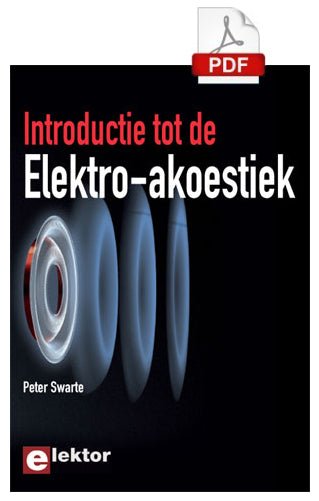
Elektor Digital Introductie tot de Elektro-akoestiek (E-book)
Dit boek is bedoeld voor diegenen die zich bezig houden met geluidsversterking en geluidsdistributie. Het gaat in op de akoestische eigenschappen van open, halfopen en omsloten ruimten. Belangrijk is hoe luidsprekers aangepast kunnen worden op allerlei omgevingen. Meestal moet men een keuze maken uit het aanbod van luidsprekers en microfoons. De vraag is dan welke luidspreker en microfoon de juiste keuze zijn. En hoe deze moeten worden opgesteld waarbij spraak- en muziekverstaanbaarheid en de maximaal haalbare versterking in de live-situatie de belangrijkste criteria zijn. Dit boek geeft antwoord op die vragen.Verder wordt de lezer meegenomen naar het ontwerpen van luidsprekers op basis van de T/S parameters. Met eenvoudige software is het mogelijk akoestische en mechanische elementen van een luidspreker met de eventuele behuizing te vertalen naar de elektrische analogieën, zodat de luidspreker op de PC gesimuleerd kan worden. Aan de hand van rekenvoorbeelden worden bovenstaande simulaties ondersteund. Tot slot zijn in de referentielijst een aantal internetlinks opgenomen waaruit zeer waardevolle gegevens gehaald kunnen worden.De auteur, Peter Swarte, is natuurkundig ingenieur en was werkzaam bij Philips. Momenteel is hij_eigenaar van consultancy bureau P.A.S. Electro Acoustics en is hij actief lid van zowel het NAG (Nederlands Akoestisch Genootschap) als de AES (Audio Engineering Society).
€ 29,95
Leden € 23,96
-

Elektor Digital Elektor Januari/Februari 2023 (PDF)
Elektor GREEN en GOLD leden kunnen deze uitgave hier downloaden.Nog geen lid? Klik hier om een lidmaatschap af te sluiten. Voor ogen en oren Video-output met microcontrollers (1)Composiet Video electronica 2022nieuws van 's werelds grootste elektronicabeurs ESP32-camerazo simpel – heeft niet eens WiFi ATX-voeding voor Raspberry Pi 32 ? KoptelefoonversterkerEenvoudige maar hoogwaardige 3-chip oplossing SDR-radioklokkenvijf tijdsignalen, zes displays Alle begin......zet een streep onder de diode Uit het leven gegrepenover de kwaliteit der dingen Reverse-engineering van een Bluetooth Low Energy LED-badgeeen BLE-apparaat besturen met een Python-script MakePython ESP32 Development KitAlles in een doosje THD-meting met een oscilloscoop en FFTgemakkelijke berekening van de vervormingsfactor Allesziende machinesde technologie achter moderne industrële visionsystemen Infographics De evolutie van spraak- en audiogestuurde elektronische apparaten WEEF 2022 terugblik FFWD elektronica 2022 terugblikde vernieuwers hebben niet nagelaten indruk te maken The Tubeeen ongebruikelijke buizenversterker Biomateriaal in elektronica: klaar of niet De Opera Cake antenne switch voor HackRF OneSluit tot acht antennes aan op uw SDR Engineering met de Arduino, en meerEen interview met auteur Ashwin Pajankar LiDAR-precisiemetermeet tot 12 meter Audiosignalen en de ESP32De ESP-ADF-omgeving in de praktijk Elektor Fortissimo-100 einversterker-kit Lichtgestuurde geluidseffectenSpanningsgestuurd 24 dB/oct synthesizerfilter (VCF) met LDR's De kilo-watter van Elektuurmeer volume gaat niet! Oost West Lab Besteen volumetrisch display in Canada Project 2.0Correcties, Updates en Brieven van lezers Hexadoku
€ 9,95
-

Elektor Digital Elektor Mai/Juin 2022 (PDF)
Vos premiers pas avec l'ESP32-C3 et l'IdOBouton Wi-Fi + relais Wi-FiCloud IdO à la sauce ArduinoDétecteur Geiger-Müller à double tube (extension pour Arduino)Capteur très sensible pour très faible rayonnementDétecteur de CO2 : CO2 GuardUne solution « maison » pour surveiller la qualité de l'airKit de mesure de la qualité de l'air pour Raspberry Pi de MonkMakesMesure de température et de CO2eDémarrer en électronique... (13)Entrée en scène de la diodeTrucs et astuces pour tester les composantsSans appareils de test coûteuxRéduction de la consommation d'énergie de votre repousse-taupesGrâce au remplacement du 555 par un ATtiny13Interrupteur crépusculaire DeLuxUne solution pour une commutation de haute précision, commandée par la lumièreLes défis de la commercialisation des solutions IdOProblématiques de sécurité, d'évolutivité et de concurrenceElektor infographieIoT : le nouveau Graal ?« Je préfère quand même être en filaire »Conseils pour développer une interface 1 Gbit/s dans un environnement industrielLa détection d'objets en temps réel pour les microcontrôleurs grâce à Edge Impulse FOMOTubes à ondes progressivesPeculiar Parts, the SeriesNB-IoTNormes, couvertures, conventions et modulesPasserelle intérieure Dragino LPS8Configuration rapide de la passerelle LoRaWANExplorer les microcontrôleurs ATtiny en utilisant le langage C et le langage assembleurExtrait : Ports d'E/S d'ATtinyÉlectronique interactive : projet 2.0Corrections, mises à jour et courriers des lecteursMise à jour de la balise GPS LoRaRecevoir et afficher la localisation à l'aide d'un Raspberry PiSimulation de circuits avec TINA Design Suite & TINACloudExtrait : oscillateurs sinusoïdauxSur le vifFaçon de pincerInfrastructure graphique WinUI pour les applications WindowsApplication de démonstrationCréation d'interfaces graphiques en Python avec guizeroLa pire des interfacesSystèmes solaires autonomesProduction d'électricité indépendante du réseau10 ans avec le même smartphone ?Et si c'était possible !Hexadoku
€ 10,95
-

Elektor Digital Artificial Intelligence (E-book)
23 projects to bring your microcontroller to life! This book contains 23 special and exciting artificial intelligence machine-learning projects, for microcontroller and PC. Learn how to set up a neural network in a microcontroller, and how to make the network self-learning. Discover how you can breed robots, and how changing a fitness function results in a totally different behavior. Find out how a PC program exposes your weak spots in a game, and ruthlessly exploits them. Build a free-will robot, or have one clean your floor! Example projects from the book: A microcontroller that learns what your favourite color is. A robot wandering about the house looking for someone to play with. A bred robot program that is incapable of crossing a black line. A microcontroller that learns how to play a game until You just can't win anymore. A PC that programs a microcontroller all by itself. Complete with free software that you can download containing: All source code for the microcontroller. All sources of compiled PC programs (MS Windows). JAL programming language, with special editor and extension libraries. Robot breed program. Plus a support webpage with links, errata and FAQ. Several artificial intelligence techniques are discussed and used in projects such as expert system, neural network, subsumption, emerging behavior, genetic algorithm, cellular automata and roulette brains. Every project has clear instructions and pictures so you can start immediately. Suggestions and literature links allow you to go way beyond the scope of the book. Even after you have built all the projects contained within, this book will remain a valuable reference guide to keep next to your PC. A unique book for anyone with an interest in artificial intelligence and machine learning.
€ 29,95
Leden € 23,96
-
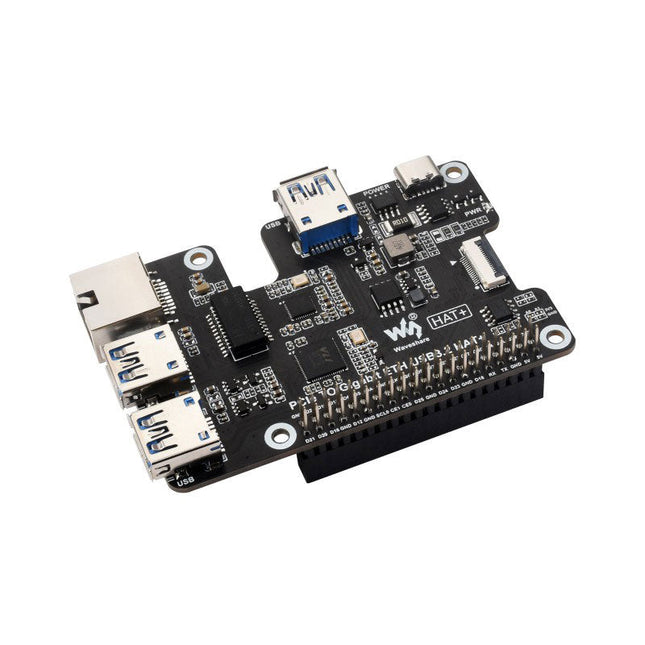
Waveshare Waveshare PCIe naar Gigabit Ethernet & USB 3.2 HAT voor Raspberry Pi 5
De Waveshare PCIe naar Gigabit Ethernet en USB 3.2 Gen 1 HAT+ is een uitbreidingskaart die speciaal is ontworpen voor de Raspberry Pi 5. Het verbetert de connectiviteit van de Raspberry Pi door drie snelle USB 3.2 Gen 1 toe te voegen poorten en een Gigabit Ethernet-poort, allemaal in een plug-and-play-configuratie zonder stuurprogramma's. Kenmerken Gebaseerd op de 16-pins PCIe-interface van Raspberry Pi 5 Uitgerust met RTL8153B krachtige Gigabit Ethernet chip Ondersteunt Raspberry Pi OS, Ubuntu, OpenWRT, enz. Stabiele en betrouwbare netwerksnelheid Realtime monitoring van de energiestatus Ondersteunt de stroomregeling van de USB-poort via software Inbegrepen 1x PCIe naar Gigabit Ethernet USB 3.2 HAT+ 1x Netwerkkabel (1,5 m) 1x 16P-kabel (40 mm) 1x Standoff-pakket Downloads Wiki
€ 32,95€ 22,95
Leden identiek
-
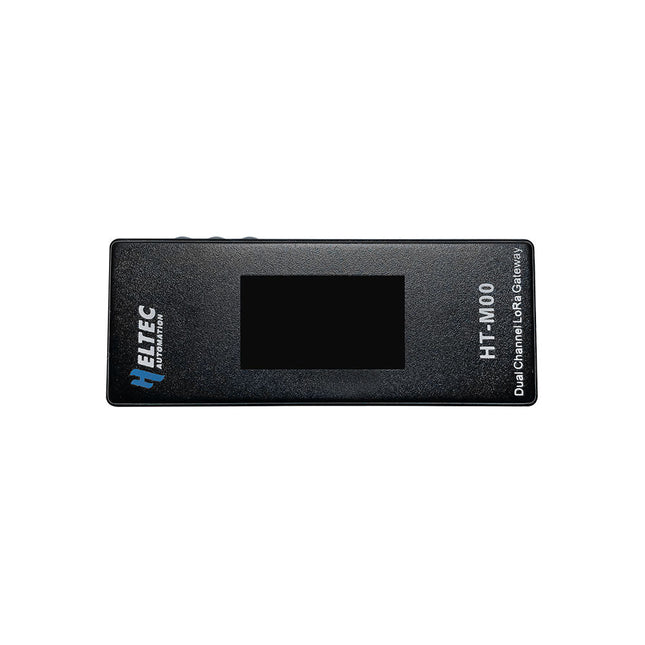
Heltec Automation Heltec HT-M00 2-kanaals LoRa Gateway (EU868)
De HT-M00 is een tweekanaals gateway die speciaal is ontworpen voor LoRa-toepassingen voor slimme gezinnen die werken met minder dan 30 LoRa-nodes. De gateway is gebouwd rond twee SX1276-chips die worden aangestuurd door ESP32. Om monitoring van de 125 kHz SF7~SF12-spreidingsfactor mogelijk te maken, is een softwaremixer ontwikkeld, die gewoonlijk een basisbandsimulatieprogramma wordt genoemd. De softwaremixer is een cruciaal onderdeel waardoor de HT-M00-gateway met hoge efficiëntie kan werken. Het is ontworpen om basisbandsignalen te simuleren, die vervolgens worden gemengd met de radiofrequentiesignalen om de gewenste uitvoer te produceren. De softwaremixer is met grote zorg en precisie ontwikkeld en heeft strenge tests ondergaan om ervoor te zorgen dat hij nauwkeurige en betrouwbare resultaten kan leveren. Kenmerken ESP32 + SX1276 Emuleert LoRa-demodulatoren Automatische adaptieve spreadspectrumfactor, SF7 tot SF12 voor elk kanaal is optioneel Maximale output: 18 ±1dBm Ondersteuning voor LoRaWAN klasse A, klasse C-protocol Specificaties MCU ESP32-D0WDQ6 LoRa-chipset SX1276 LoRa-band 863~870 MHz Voedingsspanning 5 V Ontvangstgevoeligheid -110 dBm bij 300 bps Interface USB-C Max. TX-vermogen 17dB ±1dB Bedrijfstemperatuur −20~70°C Afmetingen 30 x 76 x 14 mm Inbegrepen 1x HT-M00 2-kanaals LoRa Gateway 1x Muurbeugel 1x USB-C-kabel Downloads Manual Software Documentation
€ 74,95€ 37,50
Leden identiek
-

Seeed Studio Seeed Studio Grove 3-Axis Digitale Versnellingsmeter (LIS3DHTR)
Grove 3-Axis Digitale Versnellingsmeter (LIS3DHTR) is een goedkope 3-Axis versnellingsmeter in een bundel van Grove producten. Het is gebaseerd op de LIS3DHTR chip die meerdere bereiken en interfaces selectie biedt. Het is niet te geloven dat zo'n kleine 3 assige versnellingsopnemer I²C, SPI en ADC GPIO interfaces kan ondersteunen, wat betekent dat u elke manier kunt kiezen om verbinding te maken met uw ontwikkelbord. Bovendien kan deze versnellingsmeter ook de omringende temperatuur monitoren om de daardoor veroorzaakte fout af te stellen. Features Metingsbereik: ±2g, ±4g, ±8g, ±16g, selectie van meerdere bereiken. Meervoudige interfaces optie: Grove I²C interface, SPI interface, ADC interface. Temperatuur instelbaar: in staat om aan te passen en af te stemmen de fout veroorzaakt door temperatuur. 3/5V voeding Specificaties Voeding 3/5V Interfaces IC/SPI/GPIO ADC I²C adres Standaard 0x19, kan worden gewijzigd in 0x18 wanneer SDO Pin wordt verbonden met GND ADC GPIO stroomingang 0-3.3V Onderbreking Een onderbrekingsspeld gereserveerd SPI-Modus instellen Sluit de CS-Pin aan op GND Inclusief 1x Grove 3-Axis Digitale Versnellingsmeter (LIS3DHTR) 1x Grove kabel Downloads LIS3DHTR Datasheet Hardwareschema Arduino-bibliotheek
€ 7,95
Leden € 7,16
-

Kuongshun Intelligent Digital Temperatur Controller (W1401)
The Intelligent Digital Thermostat Temperature Controller is a small switch controller (77x51mm) which allows you to create your own thermostat. With its NTC Sensor and its LED displays, you are able to switch up to 10A 220V depending on the measured temperature.
€ 12,95
Leden € 11,66
-
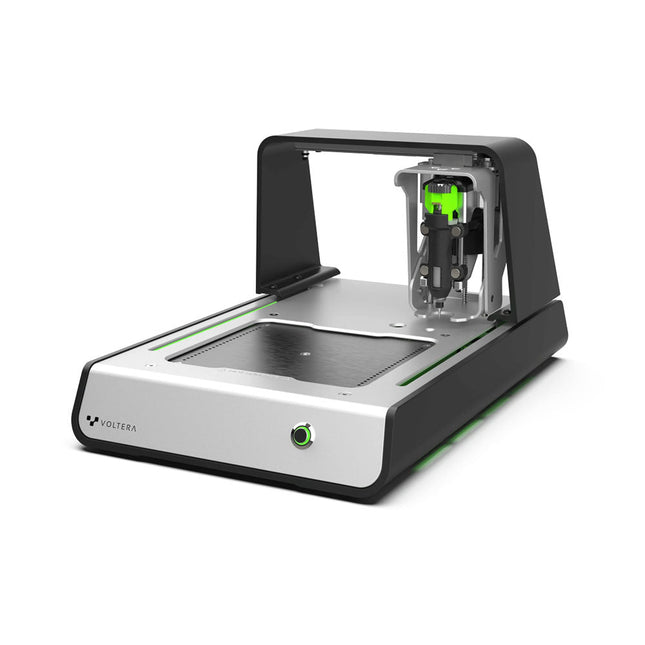
Voltera Voltera V-One Desktop PCB-printer
Soldeerpasta doseren en reflowen in één De Voltera V-One maakt dubbellaags prototype printplaten op uw eigen bureau. Gerber-bestanden gaan erin, geprinte printplaten komen eruit. De dispenser legt een zilver-gebaseerde geleidende inkt om uw schakeling ter plekke te printen. Het assembleren van printplaten is eenvoudig met de V-One's soldeerpasta verdeler en reflow functies. Plaats uw printplaat op het printbed en importeer uw Gerber-bestand in Voltera's software. Geen stencils meer nodig Voltera's software is ontworpen om gemakkelijk mee uit de voeten te kunnen. Vanaf het importeren van uw Gerber-bestanden tot het moment dat u op print drukt, leidt de software u veilig door elke stap. Compatibel met EAGLE, Altium, KiCad, Mentor Graphics, Cadence, DipTrace, Upverter. Inbegrepen V-One PCB-printer V-One dispenser V-One probe Spuitmondstuk Kopjes 3 x 4" FR1 substraatpakket 2 x 3" FR1 substraatpakket Substraatklemmen Duimschroefpakket Hello World-set Soldeerdraad Pincet Voeding Voedingsadapter Kabels Gebruiksaanwijzingen Downloads Specifications V-One Software User manuals Safety datasheets Technical datasheets Voltera CAM file for EAGLE Substrates and templates Meer Info Frequently Asked Questions More from the Voltera community Technische Specificaties Printspecificaties Minimum trace width 0.2 mm Minimum passive size 1005 Minimum pin-to-pin pitch (conductive ink) 0.8 mml Minimum pin-to-pin pitch (solder paste) 0.5 mml Resistivity 12 mΩ/sq @ 70 um height Substrate material FR4 Maximum board thickness 3 mm Soldeerspecificaties Solder paste alloy Sn42/Bi57.6/Ag0.4 Solder wire alloy SnBiAg1 Soldering iron temperature 180-210°C Drukbed Print area 135 x 113.5 mm Max. heated bed temperature 240°C Heated bed ramp rate ~2°C/s Footprint Dimensions 390 x 257 x 207 mm (L x W x H) Weight 7 kg Computervereisten Compatible operating systems Windows 7 or higher, MacOS 10.11 or higher Compatible file format Gerber Connection type Wired USB Certificatie EN 61326-1:2013 EMC requirements IEC 61010-1 Safety requirements CE Marking Affixed to the Voltera V-One printers delivered to European customers Ontworpen en geassembleerd in Canada. Meer technische informatie Quickstart Explore Flexible Printed Electronics on the V-One Voltera V-One Capabilities Reel Voltera V-One PCB Printer Walkthrough Unpacking the V-One V-One: Solder Paste Dispensing and Reflow All-in-One Voltera @ Stanford University's Bao Research Group: Robotic Skin and Stretchable Sensors Voltera @ Princeton: The Future of Aerospace Innovation
€ 5.499,00€ 4.949,00
Leden identiek























